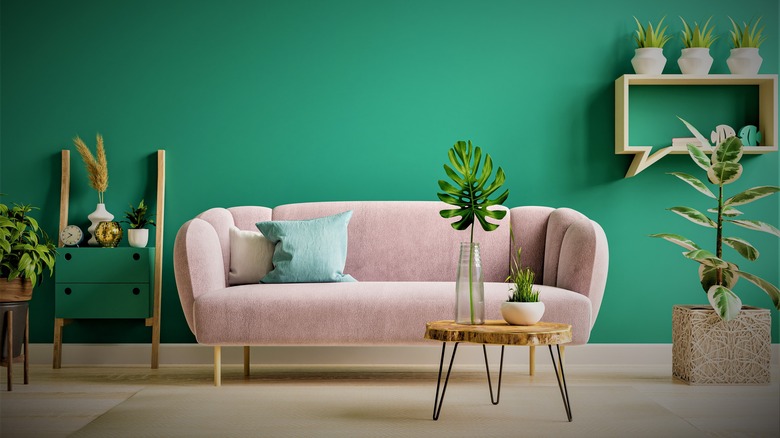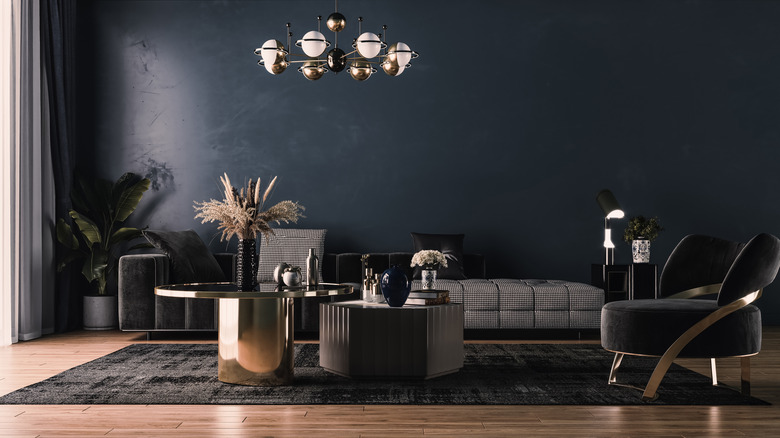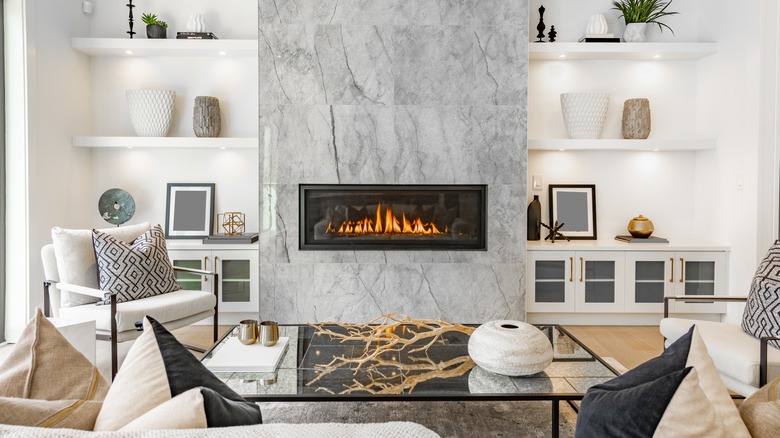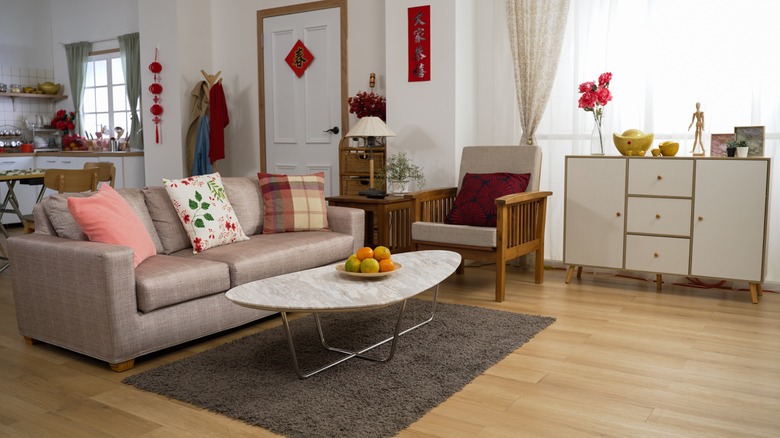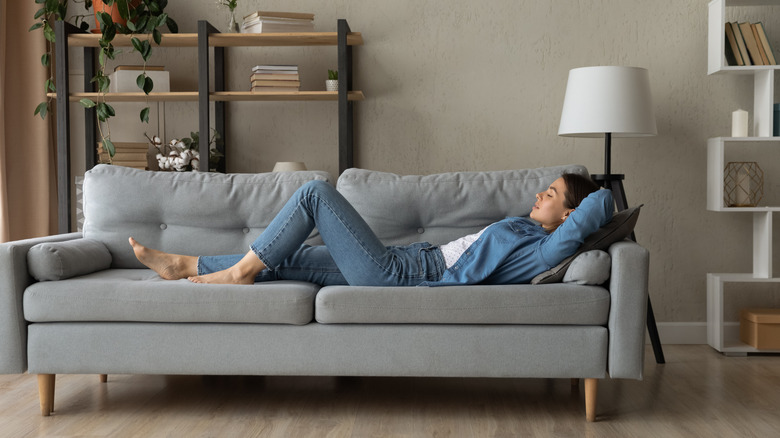How Much Does It Actually Cost To Renovate Your Living Room?
Living room renovations are a great way to target one of the most high-traffic areas of the home. Many families spend several hours each day in the living room, and an update here can make a huge difference when it comes to comfort, style, and even quality of life. Fixr reports that a living room remodel typically costs around $8,000, with substantial refinishing rising to as much as $20,000. However, some minor adjustments to the space can also be completed for under $2,000.
The scale of the project will dictate the overall spending on the finishing touches. For a small project, you might want to refit the flooring and freshen up the paint. This may also include the purchase of some new electronic equipment to amplify the entertainment value of the room. A more comprehensive renovation may see the space transformed completely, with walls removed or added, new furniture brought in, window replacements, and perhaps the installation of a brand new entertainment center. Technical updates are great, and can serve to turn the space into an outright or quasi-dedicated entertainment room in the process. U.S. News and World Report suggests that stylistic changes – molding and trim work, built-in bookshelves, a fireplace refurbishment, etc.– can impart a new sense of luxury and make for great points of focus in new space.
Factors for cost
The costs associated with a living room renovation hinge completely on the scale of your update. Bringing in a contractor to tear out walls, alter electrical wiring, or install new windows or flooring will increase the total cost. Alternatively, many of the improvements that you may be angling to include can be done quickly, and perhaps even without the help of a professional. Determining the overall goals for your remodel will help you budget for your project more effectively.
Labor costs
If you're engaging in a comprehensive remodel, chances are you'll be hiring a contractor. This is a great idea when removing a wall, refitting carpeting, or installing new hardwood floors, and in pursuit of many other major changes to the space. The labor costs associated with any of the more in-depth operations can raise the cost of your project by a substantial margin. Angi notes that many contractors will charge a percentage of the overall expense rather than a flat fee or hourly rate, commanding a typical fee ranging between 10% and 20% of the overall cost. Angi also notes that the average expense for a typical job will range around $4,000, or $300 to $500 per day, plus $150 to $250 per additional hand.
Equipment purchases
A living room remodel often comes along with the purchase of new electronics for the revamped living space. Tom's Guide reports that most televisions sold in the U.S. go for around $400 to $500, but a high-end model with greater picture quality and larger screen size can cost you well over $1,000. Knowing what you prefer and budgeting appropriately is crucial in the early planning stage. An altered landscape within the living room may very well make your current systems feel obsolete and out of place. The same goes for your speakers or surround sound system — an upgrade to the stereo functionality can have a noticeable impact on your experience.
New furniture
In addition to electronics upgrades to complement the newly painted walls, brighter window options, or flooring upgrade, you may want to add new furniture to the space to complete the change of scenery. Circle Furniture reports that a mid-range to high-end couch typically costs around $1,500 to $2,000. With couches and armchairs, you get what you pay for in the form of comfort and longevity, so purchasing the best pieces that you can afford is always good advice when in the market for these staple items. Just like with new electronics, it's a good idea to consider whether or not it makes sense to change your furniture before beginning the project so that you can work these expenses into the budget upfront to avoid hassle later in the remodel.
Additional costs
You may incur some additional costs based on the types of improvements you decide to bring into the space. These come as a result of permitting needs, the addition of warranty policies, and service costs that are attached to any new equipment you might plan to install.
Building permits
If you're adding space to the living room or knocking down walls to make the space feel more open, you may need to first acquire building permits. Angi notes that the average cost of a building permit is $1,330, but these prices can vary tremendously depending on the scope of the work to be completed. New foundation pours, basement additions, and second-story construction, for instance, require far more detailed construction planning than a change to the existing interior dimensions of your room or the addition of electrical wiring to accommodate a new device. Typically, permits fall between a range of $424 to $2,291.
It's also important to consider your own ability when it comes to renovations that involve permitting requirements. Mr. Handyman reports that structural changes and electrical improvements that typically carry this added burden are best left to the professionals, due to equipment needs, safety considerations, and skill level requirements the job may entail.
Warranty coverage
When installing new features in the home, it's a good idea to take out a warranty policy on your high-tech gear to cover routine maintenance and other areas of concern. MarketWatch reports that a typical home warranty plan costs between $360 and $900 per year, averaging (across 39 studied warranty providers) around $39 to $63 per month.
Monthly service fees
If you're installing a new smart TV, you're likely going to add additional features to give the installation the best possible functionality. For those who don't already have subscriptions to services like Amazon Prime, Netflix, or Hulu, adding these streaming features can increase the value that the living room offers on a daily basis. Many homeowners already enjoy these great services, and Variety reports that the average homeowner pays $47 per month for content streaming across all their active subscriptions.
Ongoing maintenance considerations
Maintenance costs should also be considered when reimagining your home's interior space. Unlike renters, homeowners are responsible for the ongoing maintenance tasks and expenses that come along with their property, from caring for the walls, flooring, and furniture to keeping up with utilities and monthly budgeting. Hardwood flooring, for instance, should be sanded and refinished every seven to ten years according to Bona. The same kinds of long term consideration should be placed on the furniture and carpeting elements that are present in the room. Deep cleaning fabric surfaces will keep the space fresh and beautiful for longer.
Why you need to renovate your living room
Improving the atmosphere of your home should always be at the top of your to-do list. The living room is a space that deserves increased attention because it sits centrally in most homes and acts as a public space for family gatherings, hosting friends, and more.
Comfort is key
Comfort-based improvements are key for homeowners seeking a remodel of their living room. New amenities like couches, armchairs, and entertainment updates all make for a much more enjoyable and comfortable experience in the living room. Real Homes suggests making stylistic changes to incorporate a mixture of soft materials in warm tones under dimmed ambient lighting for a peaceful atmosphere that perfectly lends itself to relaxation.
Energy efficient updates can save you over the long term
The Office of Energy Efficiency & Renewable Energy reports that residential and commercial buildings comprise 40% of the annual energy consumption in the U.S., whereas space and water heaters make up the largest share of residential consumption (45% and 18%, respectively). Focusing on energy efficiency in your renovation can save you a significant amount of money over the long term, and add value to the property at the same time. Replacing your windows with higher efficiency models will help prevent heat from leaking out into the exterior, or updating your TV to a more energy-efficient model are examples of ways you might be able to reduce your energy consumption bills. Truly, there is no shortage of ways in which your home's energy efficiency can be improved. Making this a priority during a remodel will pay you back over the long run in addition to establishing a much more comfortable living space in the process.
Personalization makes the room feel like the perfect space
Making changes that better showcase your own style and interests is a great approach to the renovation of a living room. Homeowners often bring in hardwood floors, new furniture, and other design features that make the home more elegant (and improve resale value, too, according to Architecture Art Designs). These changes also offer an opportunity to make more personal selections that align with your unique taste. You may also want to consider themed additions. Homeowners who enjoy the beach or maritime hobbies might consider installing a shiplap wall decoration while avid readers might build a bookcase that fits in around their television for an integrated statement piece.
Benefits of a living room remodel
Remodeling your living room provides a number of benefits. First and foremost, a change to this part of the home is highly impactful and efficient, as it concerns one of the most frequently used areas of your home. Additionally, homeowners who make strategic changes in this room can take advantage of increased resale value that pays back in spades.
Increased enjoyment is a hallmark of any living room remodel
Home improvements are built around increasing the functionality, comfort, and enjoyment that you feel while inside. Due to the central nature of your living room, making changes here can go a long way to transforming the environment of your home. The living room supports a wide range of activities and needs, and it's the foundational space for much of the time you spend as a family. It often serves as a workspace for school projects, may be used for family dinner time, and tends to support the evening relaxation period for members of the family after a long day of scheduled events and obligations.
The living room is the second most used room in a typical house, according to Moving Home Advice, with an average of 4.4 hours spent in the space each day. This is second only to the master bedroom, which sees a typical average usage time of 6.8 hours, including time spent sleeping. Simply put, the importance of the living room to your overall comfort and happiness in the home is apparent.
Improved resale value makes for a cost-effective change
Freys Building & Remodeling notes that homeowners often embark on renovations without a cohesive plan for remaining in the home or selling the property. It can be difficult to plan out the coming years of your life because so much can change in a heartbeat. But renovating high-impact areas of the home can provide you with the foundation necessary to facilitate a major shift in your life. You may anticipate staying in the home for many years to come, in which case, the remodel will serve your comfort and lifestyle needs admirably. However, if you are considering making a move in the coming years, renovations can help push the value and interest-grabbing features of the home over the top. According to Homes & Gardens, investments in the property like fresh paint, hardwood floors, and the smaller details that bring a room together in luxury and stylistic cohesion make for the best returns, regardless of where they are implemented within the home.
